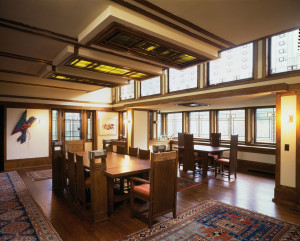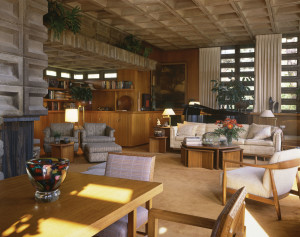 Asked to name an American architect, many immediately choose Frank Lloyd Wright. Indeed, Wright was recognized in 1991 by the American Institute of Architects as “the greatest American architect of all time.” Recognized around the world for his innovative style and modern designs, he originated and popularized the concept that structures should exist in harmony with humanity and their environment, a philosophy he called organic architecture. This concept extended not only to structures’ exteriors, but also to the interiors, furnishings and ornaments – insisting that all parts should be as one.
Asked to name an American architect, many immediately choose Frank Lloyd Wright. Indeed, Wright was recognized in 1991 by the American Institute of Architects as “the greatest American architect of all time.” Recognized around the world for his innovative style and modern designs, he originated and popularized the concept that structures should exist in harmony with humanity and their environment, a philosophy he called organic architecture. This concept extended not only to structures’ exteriors, but also to the interiors, furnishings and ornaments – insisting that all parts should be as one.

Gerald Tonkens House, Usonian Automatic, Living Area, Amberley Village, Ohio, 1954. Photograph. © Paul Rocheleau
The Franklin G. Burroughs-Simeon B. Chapin Art Museum will be the Grand Strand host of Frank Lloyd Wright: Architecture of the Interior, an exhibition exploring the design of the iconic architect’s houses, often considered his greatest architectural accomplishment. Organized by International Arts & Artists, Washington, DC, in cooperation with the Frank Lloyd Wright Foundation, Scottsdale, AZ, the exhibition will be on view from January 5 – April 7.
Through 19 reproduction drawings, eight photographs and four photographic murals, the exhibition illustrates the many ways Wright created the visual character of interior space and objects within it, each an essential detail of the larger whole. Every feature of the house – from the overall structure, to the interior, down to the smallest details and objects – was conceived by Wright from the beginning as a single idea.
The exhibit’s drawings and photographs show the ingenious ways in which Wright maximized the feeling of space while accommodating the essential functions of daily life. For example, a photograph of a very small bedroom (in the Mossberg house) shows functional furnishings built directly into the structure in order to free floor space and maintain a sense of spaciousness.
Likewise, Wright included objects in his interiors that were not merely decorative but were continuations of the overall character of the structure, engaging the viewer’s senses of sight and touch with color, texture, pattern, contour, light and shadow. The works in Architecture of the Interior reveal how all elements in Wright’s designs express the overarching abstract geometric order of the house.
During his seven-decade-long career, Wright designed more than 1,000 structures, 532 of which were constructed. These included offices, churches, schools, skyscrapers, hotels and museums. Wright also designed many of the interior elements of his buildings, such as the furniture and stained glass.
As perhaps the quintessentially American architect, Wright’s home design concepts evolved over a period when the lifestyle of the American family changed from the formality of the Victorian era to the informal, consumer-based lifestyle of the modern age. He used a vocabulary of abstraction and geometry based on forms found in nature to create a new, contemporary visual language in his architecture and design.
Popular in his own lifetime, Wright continued to receive much recognition for his achievements even after his death, including numerous architectural awards, a play and an opera based on his life and work. In 1966, the United States Postal Service honored Wright with a Prominent Americans series postage stamp. Several of Wright’s buildings have been proposed by the United States to be UNESCO World Heritage sites. Numerous Wright homes and other structures continue to be popular tour destinations administered by the Frank Lloyd Wright Trust and toured by thousands of visitors each year.
Gallery hours for Architecture of the Interior will be from 10 a.m. – 4 p.m. Tuesday through Saturday, 1 – 4 p.m. Sunday, beginning Tuesday, Jan. 5. Admission to the Art Museum is free at all times, but donations are welcomed.
For more information, call 843-238-2510 or visit MyrtleBeachArtMuseum.org.
